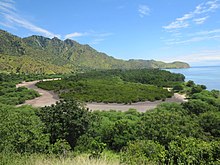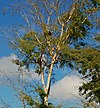Flora of Timor

The island of Timor is part of the Wallacea area . The flora of Timor is thus part of the biogeographical transition zone between the Asian and Australian flora and fauna .
Vegetation of East Timor
Overview

It is estimated that there are around 2500 species of plants in East Timor alone . In a 2006 field study alone, 22 new species were discovered. The vegetation consists mainly of secondary forest , savannas and grasslands . There are mostly species from the casuarina family , eucalyptus , sappan wood , sandalwood and palmyra palms (Lontar palms). Common tree species include Sundacarpus amarus , Dacrycarpus imbricatus , Eucalyptus alba , Elaeocarpus species, Artocarpus pomiformis , Drypetes species , Olea paniculata and Putranjiva roxburghii .
Dense forest can only be found in the south and in the mountain regions. The total area of forest in East Timor (excluding Oe-Cusse Ambeno ) decreased by almost 30% between 1972 and 1999. In the last ten years of the Indonesian occupation alone, the proportion of forests in the whole of East Timor fell by 18%. The area of the original primary forest of East Timor has shrunk to 220,000 hectares or 1% of the territory. The primary forest is dominated by an abundance of trees with relatively large, fleshy fruits that are particularly attractive to birds. They could depend on fruit pigeons and flying foxes for the distribution of their seeds . These fruit trees are absent in the thorn and dry secondary forests. Local fruits are salak , jackfruit , jambul ( jamblang ), uha , saramalé and aidák .
Acacia leucophloea in West Timor near Kupang
Indian coral tree (Erythrina variegata) in Kupang
Acacia leucophloea in South Central Timor
Light walnut in south central Timor
Some screw palms in a wetland near Lospalos
Avicennia marina on the shores of Lake Malai
Mangroves
Mangrove forests cover, depending on the source, only about 750 to 7500 hectares of East Timor, as in contrast to other islands of the archipelago there are few bulges in the coastline. The country's few mangrove forests are found along a few beaches and estuaries. They are found scattered in all communities that have a sea coast, but they mainly occur on the north coast, where the sea is calmer. For example at Metinaro ( municipality of Dili ), Tibar and Maubara (municipality of Liquiçá ). On the south coast, the mangroves do not extend much further than beyond the estuaries and swampy terrain. In Tetum they are locally called Ai-Parapa , which means “trees that live in the water”.


Mangrove species in East Timor:
- Acanthus ilicifolius
- Acrostichum aureaum
- Aegiceras corniculatum
- Avicennia marina
- Bruguiera cylindrical
- Bruguiera gymnorrhiza
- Bruguiera parviflora
- Ceriops australis
- Ceriops tagal
- Excoecaria agallocha
- Heritiera littoralis
- Lumnitzera racemosa
- Rhizophora apiculata
- Rhizophora mucronata
- Rhizosphora stylosa
- Sonneratia alba
- Sonneratia caseolaris
- Sonneratia urama
- Xylocarpus granatum
Other plant species in mangrove forests:
- Barrintonia asiatica
- Barrintonia asiatica
- Callophyllum inophyllum
- Cerbera manghas
- Derris scandens
- Derris trifoliate
- Linden-leaved marshmallow ( Talipariti tiliaceum )
- Goat's foot morning glory ( Ipomoea pes-caprae )
- Pemphis acidula
- Premna serratifolia
- Scaevola taccada
- Suriana maritime
- Katappenbaum ( Terminalia catappa )
- Ryssopterys timoriensis
- Pandanus tectorius
Plant species on the red list
| Plant species of East Timor on the IUCN Red List | ||
|---|---|---|
| family | Scientific name | information |
| Acanthus family (Acanthaceae) | Acanthus ilicifolius | IUCN status: not at risk |
| Burmanniaceae | Burmannia disticha | IUCN status: not at risk |
| Horn leaf (Ceratophyllaceae) | Ceratophyllum muricatum | IUCN status: not at risk |
| Sourgrass family (Cyperaceae) | Carex baccans | IUCN status: not at risk |
| Sourgrass family (Cyperaceae) | Cyperus compactus | IUCN status: not at risk |
| Sourgrass family (Cyperaceae) | Diplacrum caricinum | IUCN status: not at risk |
| Sourgrass family (Cyperaceae) | Echinochloa picta | IUCN status: not at risk |
| Sourgrass family (Cyperaceae) | Eleocharis geniculata | IUCN status: not at risk |
| Sourgrass family (Cyperaceae) | Eleocharis retroflexa | IUCN status: not at risk |
| Sourgrass family (Cyperaceae) | Fimbristylis argentea | IUCN status: not at risk |
| Sourgrass family (Cyperaceae) | Fimbristylis bisumbellata | IUCN status: not at risk |
| Sourgrass family (Cyperaceae) | Fimbristylis consanguinea | IUCN status: not at risk |
| Sourgrass family (Cyperaceae) | Fimbristylis dipsacea | IUCN status: not at risk |
| Sourgrass family (Cyperaceae) | Fimbristylis nutans | IUCN status: not at risk |
| Sourgrass family (Cyperaceae) | Fimbristylis ovata | IUCN status: not at risk |
| Sourgrass family (Cyperaceae) | Fuirena pubescens | IUCN status: not at risk |
| Sourgrass family (Cyperaceae) | Lipocarpha gracilis | IUCN status: not at risk |
| Sourgrass family (Cyperaceae) | Pycreus macrostachyos | IUCN status: not at risk |
| Sourgrass family (Cyperaceae) | Pycreus sanguinolentus | IUCN status: not at risk |
| Sourgrass family (Cyperaceae) | Schoenoplectiella lateriflora | IUCN status: not at risk |
| Sourgrass family (Cyperaceae) | Scleria mikawana | IUCN status: not at risk |
| Sourgrass family (Cyperaceae) | Scleria terrestris | IUCN status: not at risk |
| Legumes (Fabaceae) | Parochetus communis | IUCN status: not at risk |
| Halagoraceae | Myriophyllum tuberculatum | IUCN status: not at risk |
| Leguminous plants (Leguminosae) | Sesbania javanica | IUCN status: not at risk |
| Duckweed family (Lemnaceae) | Lemna minor | IUCN status: not at risk |
| Lygodiaceae | Lygodium microphyllum | IUCN status: not at risk |
| Sweet grasses (Poaceae) | Brachiaria eruciformis | IUCN status: not at risk |
| Sweet grasses (Poaceae) | Eriochloa procera | IUCN status: not at risk |
| Sweet grasses (Poaceae) | Leptochloa fusca | IUCN status: not at risk |
| Sweet grasses (Poaceae) | Leptochloa obtusiflora | IUCN status: not at risk |
| Sweet grasses (Poaceae) | Leptochloa panicea | IUCN status: not at risk |
| Stonecaceae (Podocarpaceae) | Podocarpus rubens | IUCN status: not at risk |
| Stonecaceae (Podocarpaceae) | Sundacarpus amarus | IUCN status: not at risk |
| Stonecaceae (Podocarpaceae) | Cladopus nymanii | IUCN status: not at risk |
| Figwort family (Scrophulariaceae) | Lindernia antipoda | IUCN status: not at risk |
Orchids
The three most important protected areas for orchids in East Timor are on Monte Mundo Perdido , Tatamailau and Fatumasin . In 2009 several new species were discovered on Monte Mundo Perdido.
According to a 2008 by Silveira et al. published checklist, the following 66 orchid species from 38 different genera are known. Ten of East Timor's orchids are considered endemic.
-
Aerides
- Aerides timorana - endemic to Timor
- Aerides odorata
-
Bulbophyllum
- Bulbophyllum sundaicum
- Bulbophyllum cf. concinnum
- Bulbophyllum sp. (Section Aphanobulbon )
-
Cadetia
- Cadetia sp. ( Cadetia Section )
- Caladenia
- Calanthe
-
Coelogyne
- Coelogyne sp. (Section Tomentosae )
-
Crepidium
- Crepidium sp. A (Section Crepidium ) - possibly endemic to Timor
- Crepidium sp. B (Section Hololobos ) - possibly endemic to Timor
- Dendrobium
- Didymoplexis
-
Diuris
- Diuris fryana - endemic to Timor
- Eria
- Eulophia
-
Flickingeria
- Flickingeria grandiflora
- Flickingeria sp.
- Geodorum
- Geodorum densiflorum
- Goodyera
-
Grosourdya
- Grosourdya sp.
-
Habenaria
- Habenaria ankylocentron - endemic to Timor
- Habenaria carinata
- Habenaria cauda-porcelli - endemic to Timor
- Habenaria elongata
- Habenaria giriensis
- Habenaria malintana
- Habenaria multipartita
- Habenaria cf. plantaginea
- Habenaria sp. A (Section Plantaginea ) - endemic to Timor
- Habenaria sp. B (Section Plantaginea ) - endemic to Timor
- Habenaria sp. C (Section Plantaginea ) - endemic to Timor
- Habenaria sp. D ( Salaccenses Section )
- Habenaria viridiflora
- Herminium
- Hetaeria
-
Liparis
- Liparis aurita - endemic to Timor
- Liparis gibbosa
- Luisia unguiculata - endemic to Timor
- Luisia sp.
- Microtis
- Nervilia
-
Oberonia
- Oberonia glandulifera - endemic to Timor
- Oberonia sp. A.
- Pecteilis
-
Peristyle
- Peristylus goodyeroides
- Peristylus timorensis - endemic to Timor
- Pholidota
- Platanthera
- Polystachya
-
Pterostylis
- Pterostylis timorensis - endemic to Timor
-
Spathoglottis
- Spathoglottis cf. aurea
- Spathoglottis plicata
- Spiranthes
-
Thelymitra
- Thelymitra forbesii - endemic to Timor
-
Thrixspermum
- Thrixspermum sp. A.
- Thrixspermum sp. B (Section Dendrocolla )
- Thrixspermum subulatum
-
Trichoglottis
- Trichoglottis cf. koordersii
- Trichotosia sp. A - possibly endemic to Timor
- Tropidia
- Vanda
See also
literature
- Paulo Silveira, André Schuiteman, Jaap Jan Vermeulen, Ana J. Sousa, Helena Silva, Jorge Paiva, Ed De Vogel: The orchids of Timor: checklist and conservation status. In: Botanical Journal of the Linnean Society , Volume 157, Number 2, 2008, pp. 197-215, DOI: 10.1111 / j.1095-8339.2008.00796.x , PDF.
- Geoffrey Hull: Timorese Plant Names and their Origins , 2006.
Web links
- Coimbra University on the Forests of Timor ( Memento of May 3, 1999 in the Internet Archive ) (Engl.)
- Animals and plants unique to Timor
- Sean WM Collins, Xisto Martins, Andrew Mitchell, Awegechew Teshome and John T. Arnason: Fataluku medicinal ethnobotany and the East Timorese military resistance , Journal of Ethnobiology and Ethnomedicine, 2007.
- Ian Cowie: A Survey of Flora and Vegetation of the Proposed Jaco – Tutuala – Lore National Park, Timor-Leste (East Timor) , NT Herbarium (DNA), Department of Natural Resources, Environment and the Arts, Palmerston, NT, May 2006
- Geoffrey Hull: Timorese Plant Names and their Origins , Instituto Nacional de Linguística, Dili, 2006, 1-74138-222-X 978-1-74138-222-8.
Individual evidence
- ↑ a b c d GOVERNMENT OF TIMOR-LESTE, THROUGH THE SECRETARIA DE ESTADO DOS RECURSOS NATURAIS: Tasi Mane - Suai Supply Base EIA Terrestrial Flora and Fauna Technical Report , March 23, 2012 .
- ^ Laura Suzanne Meitzner Yoder: Custom, Codification, Collaboration: Integrating the Legacies of Land and Forest Authorities in Oecusse Enclave, East Timor. P. 104, dissertation, Yale University, 2005 ( PDF file; 1.46 MB ( memento of March 7, 2007 in the Internet Archive )).
- ↑ a b Konservas Flora & Fauna: Potensia Mangrove iha Timor-Leste (2016)
- ↑ Bird life International: A lost world in Timor-Leste - Mount Mundo Perdido, A profile of its biodiversity and conservation (PDF; 755 kB)
- ↑ Paulo Silveira, André Schuiteman, Jaap Jan Vermeulen, Ana J. Sousa, Helena Silva, Jorge Paiva, Ed De Vogel: The orchids of Timor: checklist and conservation status. (PDF; 661 kB) In: Botanical Journal of the Linnean Society , Volume 157, Number 2, 2008, pp. 197-215, DOI: 10.1111 / j.1095-8339.2008.00796.x













